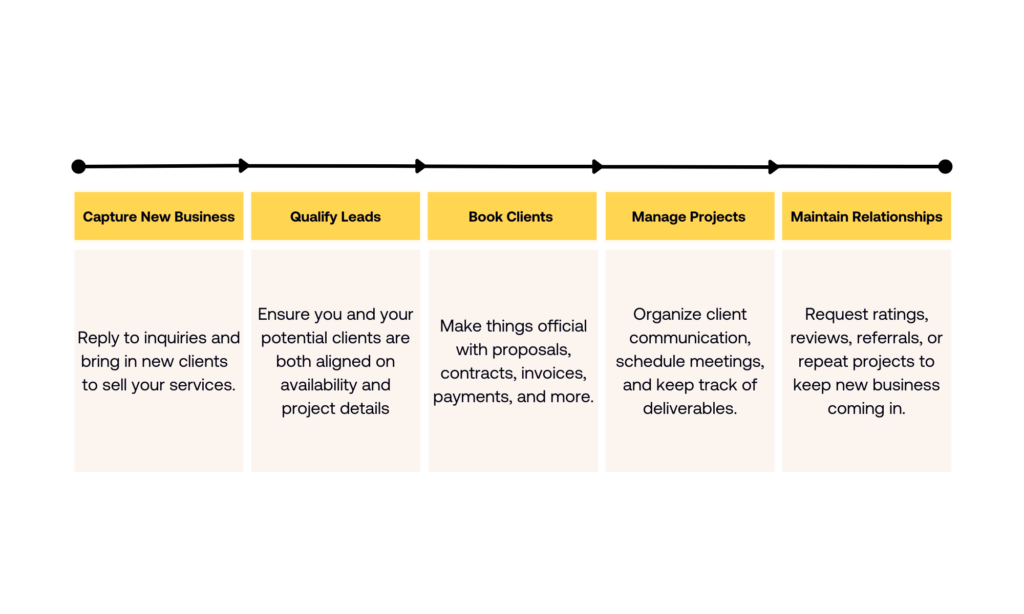A clientflow is something you already have as an independent business owner. Understanding it empowers you to improve the way you interact with clients and run your business from the initial interaction to project closure. Learn more and download our free process mapping template to optimize your clientflow!

Providing a service tailored to a client’s needs is an interactive process between an independent business and a client. This type of process involves several critical steps to obtain the right information and alignment for a successful project outcome. Think of the services offered by graphic designers, photographers, business coaches, marketing consultants, virtual assistants, and much, much, more.
The term used to describe this process of selling and delivering personalized services to clients is called a clientflow. The clientflow includes both the client-facing and back-end work that go into every project—like sending proposals and contracts as well as communication, service selection, and payment.
Though this might be a new term for you, you already have a clientflow if your business is based on delivering your talent as a service.
Jump to:
- Why think of your process as a clientflow?
- What are the steps inside a clientflow?
- Capture new business
- Qualify leads
- Booking
- Manage projects
- Maintain relationships
- How do I create a clientflow? (+ process mapping template)
- How do I manage my clientflows?

Why think of your process as a clientflow?
Evaluating your work processes as a clientflow allows you to think holistically about how you run your business. The term itself is the combination of the words “workflow” and “client journey or experience,” which are the two essential parts of running an independent business. By combining them we understand how these two vital processes, which are often siloed, are actually intertwined and influenced by each other.
For example, to create a frictionless booking experience on the front end, you need to be mindful of how you design and automate your service selection, contract, and payment steps on the back end. By understanding the relationship between your workflows and client journey you’ll be able to work more efficiently, reduce back-and-forth, and seamlessly flow clients through the experience of working with you.

Before you even start a project, your client has to discover your business. Then they likely go through your onboarding steps, like filling out an intake questionnaire, signing a contract, and paying for your services. At the same time, you’re completing steps like responding to their inquiry, creating a proposal, and sending an online invoice.
The way you set up your business in the back-end during these steps directly impacts your client experience when they’re inquiring and working with you. Your booking process can make your clients feel confident, or it could bring up more questions about payment, next steps, and expectations.
Thinking about your process as a clientflow empowers you to work more efficiently and better provide for your clients at every stage because it makes you aware of all of the dependencies required to make a project successful.
What are the steps inside a clientflow?
Though every business varies, your clientflow will likely include the following steps. To determine the exact process you use, map your clientflow first to see which steps you use and in what order.
Capture new business
- Marketing and lead generation
Qualify leads
- Mutual qualification
Booking clients
- Service selection
- Contract signing
- Invoice and payment
Managing projects
- Execution
- Deliverable or service
Maintain relationships
- Project closure
- Renewal decision
- Making a recommendation or referral
Capture new business
This is the earliest stage in your clientflow that happens as you become aware a potential client is interested in your services. During this phase, you and your client gather information about each other.
Marketing and lead generation
Your potential client has a need they’re looking for a service provider to meet. To find an independent business they trust to accomplish this task they’re browsing social media, searching online, and asking friends for recommendations. Your marketing efforts like SEO, social media, and digital advertising can all help a client discover your business during this information-gathering step.
Qualify leads
Once you have a healthy pool of leads coming in, not all of them will convert to clients. In order to move forward to booking, you and your leads need to mutually decide if you’re a good fit and aligned on availability and project details.
Mutual qualification
A potential client has reached out to you, through a contact form on your website, for example, to learn more about your pricing and services. At this stage, you should have a clear process for communicating with your leads efficiently as well as criteria to determine if they’re the right fit for your business. Evaluating customer fit is vitally important for service-based businesses because they’re highly relationship-dependent.
Qualifying leads includes assessing whether your services and prices fall within the potential client’s expectations. These sales conversations are also an important part of determining customer fit. If expectations are aligned, the potential client is ready to move on to service selection and the booking stage of your clientflow.
Booking clients
Once you know a potential client is a good fit for your business, you can move forward with the booking process. These steps are important to confirm the services provided, set expectations, and protect your business.
Service selection
You’ve had the necessary conversations with your potential clients or pointed them to the right information, and they’re ready to make a purchasing decision. At this step, they’ll consider the initial impression they got of your business and which services best fit their needs along with your reputation, pricing, and more.
Depending on your business, you can send a pricing guide that your clients can use to choose their services on their own. Or, if you have a more hands-on sales process, you can send a custom proposal that’s personalized to the needs you’ve already discussed.
Contract signing
You’re both ready to move forward, but you need to set expectations first. It’s important that your clients always sign a contract before you begin working together so you know they’re agreeing to the scope of work, pricing, timeline, terms of service, and more. A contract should include specific clauses relevant to your industry to protect your business from anything unexpected. For example, an event professional may include a force majeure clause to protect against any event that prevents them from performing their contractual obligations.
Invoice and payment
Sending an invoice and collecting payment might seem like an easy step in your clientflow, but it’s important to do so professionally. Your clients expect to experience a seamless payment process, especially in today’s digital-first world, so providing one won’t set your business apart.
However, precisely because they expect it, delivering anything less than seamless can have a dramatically negative impact on a client’s impression of your business. They’ll notice if this step feels difficult, or worse, unsecured. Frictionless online payment software in a secure environment is a must.
Managing projects
As your project gets underway, you’ll need a process to keep your client informed as the work progresses and to ensure you have everything you need from them to deliver the final result to your highest ability.
Execution
Communication is key through your clientflow, but it’s especially important once the work has begun to ensure project alignment, progress reporting, and relationship building. Make sure you’re communicating with your clients consistently in their preferred methods and meeting their needs every step of the way.
Service and deliverable
For most types of independent businesses, you likely offer a service that leads up to a deliverable (like graphic design, event planning, and photography). When your client receives the deliverable or service, there shouldn’t be any surprises or difficulties, which is also why communication is so important.
For other businesses, this step may be the longest in your clientflow. For example, if you’re a business consultant that works on a retainer, you’ll be continually providing services and deliverables throughout your contract timeline.
Maintain relationships
You may think a project is complete once the service has been rendered or the final result is delivered, but there is a final phase in your clientflow. It is critical to your business outcomes and includes asking for feedback, reviews, or referrals, as well as offering renewal options when applicable.
Project closure
Once your project is complete, be sure to thank your client for their time and ask them for feedback. You can send a quick survey with questions about what they appreciated and what you can improve on for next time.
If you have a deliverable to send, be sure to do so in a professional manner that creates a great experience. You might want to send your digital deliverables but offer a physical copy as well.
Making a review or referral
You’ve put all this time and energy into cultivating and providing an exceptional client experience, now ensure you’re leveraging that positive impression to entice future clients by asking for a recommendation or referral. If expectations were met, and ideally exceeded throughout the clientflow, it’s highly likely your client will agree to write a positive review and/or make a referral.
Renewal decision
For many businesses, you have the possibility of offering more services to clients. Perhaps you’ve already designed a logo but there’s a good fit for web design as well, or maybe you’ve completed an initial consulting project and the client is interested in keeping your services longer.
For some businesses, this step is more consequential than others. Consulting is a great example because your value is often greater when you can provide services over a longer period of time. If this is applicable to your business, clients will consider every step of the clientflow to decide if they’d like to work with you again in the future.
How do I create a clientflow?
As mentioned, most independent business owners already have a clientflow. Unless you’re a brand new business, you likely have a process of how you communicate and exchange information with your clients to get from the first inquiry to the final payment and referral.
So you may not necessarily need to create a new clientflow but rather think about how you can optimize your existing processes. With a clientflow management platform, like HoneyBook, you can easily identify opportunities for improvement and create a more streamlined experience that takes the entire client journey into consideration.
Start by mapping your current or desired clientflow. Consider each step that we listed above and ask the following questions:
How do your clients find you?
This is where you can optimize your marketing to gain more leads, whether it’s through your website, social media, or other.
How do you follow up with leads?
Consider how long it takes to follow up with leads when they initially contact you. You can optimize here by using automations synced with your contact form and an updated scheduling tool to send and keep the conversation moving forward.
How do your clients select services?
If your clients already know what services they need by the time they contact you, make sure your pricing and service packages are clear on your website or elsewhere. If they need a little more assistance, you can build custom proposals that help them decide what to choose.
How do you book your clients?
This process looks different for everyone. You might send your contract first and collect full payment, or collect a deposit and wait for full payment later. By understanding the process you use, you might find that you can combine multiple steps to book even faster, such as sending an online proposal that contains both invoice and contract.
How do you communicate throughout a project?
Depending on your services, you might need constant contact with your clients or just a few milestone touchpoints. You may find that you’re communicating the same things to multiple clients, so you can benefit from automation at this step as well.
How do you close your projects?
When you finish projects, are you trying to maintain the relationship? There should be some next steps beyond “thank you,” whether you’re asking for reviews online, offering additional services, or adding them to your nurture emails.
Documenting your clientflow is an exercise in understanding your business processes better. This will take some time, but it’ll be worth it in the end. To make things easier, use our process mapping worksheet. It will guide you through many of the same questions above and help you think through what you’re already doing as well as which steps you can optimize.
Use our process mapping worksheet to understand your clientflow
Download the template for free to document the answers to each question above and view a sample clientflow.
Map my ProcessHow can I manage my clientflow?
Thinking of your process as a clientflow is about understanding the complete client experience. The best way to create and streamline your clientflow is with a platform that can address them all: client communication, scheduling, creating and sending essential files, processing payments, and more.
HoneyBook is the leading clientflow management platform and with it, you can build, manage, and optimize your clientflow all in one place. Regardless of your process, there’s a HoneyBook feature to support each step:
- Capturing new business – Embed a contact form on your website or link it in your social media profiles to capture leads in all the places where they find you. You can also link to your meeting scheduler to seamlessly set up intro calls.
- Qualifying leads – Use your contact form to ask the right questions in order to determine which clients are a good fit. Or, create questionnaire templates that you can send automatically to gather more information. You can also schedule discovery calls to learn more about each new lead.
- Service selection – Create pricing guides or sales brochures that help potential clients understand exactly what you offer, tailored to their needs. You can also build questionnaires to capture more information so you can guide their service selection efficiently.
- Contract signing – Send an online contract populated with your clients’ service selection and use templates with the clauses and terms appropriate for your business.
- Invoice and payment – Send an invoice that allows your clients to pay online seamlessly while also letting you set up recurring payments and reminders to automate the process.
- Communication and work process – Sync your email with HoneyBook to view client communication in one place and trigger reminders for each deliverable or project milestone.
- Deliverable or service – Use the calendar tool to track deliverables and milestones, and automate internal reminders for each step, whether your service is an event, a digital product like a logo or website, or a long-term project that may include consulting and one-on-one support.
- Making a recommendation or referral – Create automated emails that are triggered at the end of a project to remind clients to review your service or offer incentives for referrals.
- Renewal – There are multiple ways your clients can renew with you, whether that means moving forward with an additional service, expanding the current project, or offering an add-on. Turn on recurring payments or easily adjust your proposal templates to renew and kick off new projects.
Throughout your work, you can also use HoneyBook’s clientflow automation to make sure your steps are flowing together in the best way.
Build and manage your clientflow with HoneyBook
Try our tools for each step of your clientflow. By managing everything in one place, you can better serve your clients!





